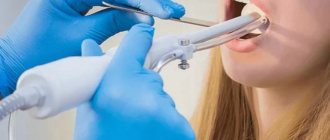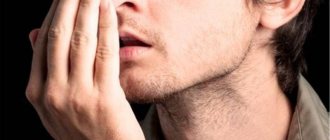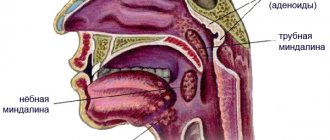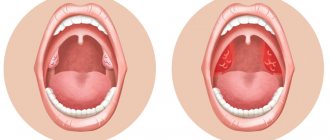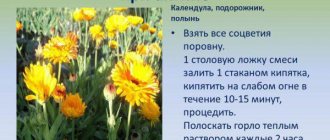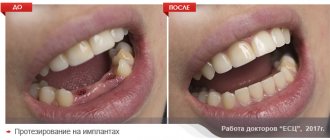What are lacunae
The tonsils are covered on the outside with a mucous membrane with depressions called lacunae. They protect the body from pathogens and ensure filtration of everything that enters the mouth.
In the follicles that make up the tonsils, lymphocytes mature and are released onto the surface of the lacunae to destroy microbes. In a healthy person, the lacunae cleanse themselves.
What are tonsils, structural features
The immune system consists of many components. They participate in the formation of the body’s immune response to pathogenic agents when attempting to introduce them. The tonsils are considered an important part of it. They are accumulations of lymphoid tissue. The tonsils are located in the mucous membrane lining the pharynx. Formations become the first filter on the path of infection into the body.
Together with other accumulations of lymphoid tissue, they form the pharyngeal ring. Tonsils have a complex structure. They are pierced by winding deep channels called crypts. Branching reaches the third or even fourth order. Their number is usually from 16 to 18 pieces. The epithelium covering the walls of the crypts is associated with lymphoid tissue over a large area.
These formations are most developed in the area of the upper pole of the tonsil. In their lumen, desquamated epithelial cells, food debris, leukocytes, and lymphocytes accumulate. Bacteria actively multiply in this environment. This structure promotes the development of chronic inflammatory processes inside the crypts.
Why is rinsing prescribed?
When immunity decreases, the production of lymphocytes decreases, and an inflammatory process begins in the lacunae. As a result of the disease, the ability to cleanse itself decreases and the recesses of the tonsils become clogged with purulent plugs.
The person’s health deteriorates and the following appears:
- heat,
- severe sore throat
- difficulty swallowing.
With frequent such manifestations, doctors diagnose chronic tonsillitis. And rinsing is prescribed to prevent the spread of infection to other organs.
This stops the exacerbation of tonsillitis and in some cases eliminates the need for surgical intervention to remove the tonsils. Washing is almost painless, as doctors use modern equipment to carry it out quickly.
Important! It is dangerous to clean lacunae on your own due to the risk of damaging the delicate mucous membrane of the palate and pharynx.
Syringe rinsing technique
The technique is used in all clinics. Washing is carried out in a treatment room. A syringe is used, on which a special curved metal tube is placed - a cannula.
- An antiseptic solution is drawn into the syringe.
- The free end of the cannula is brought to the lacunar fold filled with pus.
- By pressing the piston, a medicinal solution is supplied into the cavity.
- Together with pus from the tonsil, the liquid is poured into the patient’s oral cavity and then spat into a ditch.
- After washing out the purulent exudate, Collargol or Lugol's solution is applied to the tonsils.
While flushing, you need to inhale through your nose. If the nasal passages are congested, it is recommended to use nasal vasoconstrictor drops to ensure free breathing. To reduce the urge to vomit that appears when the tonsils are irritated, the sound “a” is pronounced.
People suffering from chronic tonsillitis often try to rinse their tonsils on their own during an exacerbation of the disease. Despite the fact that a special syringe with a cannula is sold in pharmacies, and the procedure seems simple, you should not rinse the tonsils yourself. Inept actions can damage the mucous membrane or cause the infection to spread to nearby tissues.
It is allowed to wash the lacunae yourself if it is not possible to see a doctor. The algorithm of actions is similar to that carried out by a doctor:
- spray antiseptic on tonsils for disinfection;
- open your mouth wider and stick out your tongue;
- breathe through your nose, taking shallow breaths;
- direct the stream from the cannula to the purulent accumulation;
- spit out the solution that has leaked out with pus.
However, you must understand that performing the procedure yourself can aggravate the process due to damage to the mucosa. In addition, the effectiveness of self-washing is significantly lower. If possible, it is better to entrust the manipulation to a specialist.
Types of washing
Purpose of appointment: to remove pus from the lacunae and treat them with a drug. After this, the patient's condition improves significantly.
Specialists carry out the procedure in different ways:
syringe. A solution is drawn into a 20-gram syringe. Instead of a needle, a special nozzle with a curved end is put on so that the solution falls directly on the stopper. The liquid under the pressure of the piston is fed into the lacuna and flushes it.
Washing the tonsils- Vacuum method of washing tonsils . The tonsils are anesthetized, a vacuum suction cup is attached to them, through which the purulent contents are pumped out. After this, the medicinal composition is pumped into the lacuna.
- Ultrasonic washing of tonsils . The cleaning principle is based on a combination of cavitation and ultrasound. Air bubbles form in the washing liquid, and when they rupture, the membranes of microbial cells are damaged.
The Kuntsevo Medical Center has modern otolaryngological equipment, which allows the operation to be performed as quickly, efficiently and painlessly as possible.
Indications for rinsing
The accumulation of pus in the lacunae in acute or chronic tonsillitis is additionally accompanied by a deterioration in general health and the appearance of signs of intoxication. In acute cases, taking antibiotics, rinsing and bed rest helps, but in chronic cases, such treatment methods are ineffective. Often, rinsing is the only way to remove purulent exudate from lacunar folds. For chronic tonsillitis, otolaryngologists recommend sanitation of lacunae at least 2 times a year. Rinsing will allow you to prolong periods of remission and restore the functioning of the organ. Rinsing is also indicated for adenoids - a pathological enlargement of the pharyngeal tonsil. If conservative therapy is prescribed for adenoiditis, then lavage is included in the list of therapeutic methods.
How is the procedure performed?
All rinsing methods are based on exposing the tonsils to a stream of disinfecting solution or vacuum. Cleaned tonsils are treated with medications.
Processing each tonsil takes from 30 seconds to 1.5 minutes. The time depends on the choice of type of cleaning of the lacunae and the depth of damage to the lacunae.
Important! Before the procedure, you cannot eat for 1.5-2 hours. This is due to the fact that rinsing provokes a gag reflex.
To prevent possible discomfort, the doctor treats the tonsils with a local anesthetic with lidocaine or novocaine in the form of a spray.
Means for washing tonsils
In principle, any antiseptic solution is suitable. Its main characteristics should be the following:
- non-toxic if swallowed;
- chemically neutral so as not to cause burns to the mucous membrane;
- has a bactericidal effect, especially on streptococci and staphylococci - the main pathogens of tonsillitis. It’s not bad if the solution also has antiviral and antifungal effects;
- the temperature of the solution used should be about 37°C.
The most commonly used solution is Furacilin, as well as Chlorhexidine, Miramistin, and various bacteriophages. At the end of the procedure, the tonsils are treated with Lugol's solution. At home, rinsing with a decoction of herbs (sage or chamomile) is recommended.
Contraindications
Treatment of lacunae is not prescribed for patients with:
- exacerbation of other chronic diseases, including caries;
- cancer diagnoses;
- in the 1st and 3rd trimester of pregnancy;
- pathology of the retina;
- severe pathologies of the heart and blood vessels;
- up to 3 years of age.
For hypertension, consultation with a specialized specialist is required.
Important! It is necessary to warn the doctor about any existing individual intolerance to drugs.
Procedure methods
If plaque appears on the tonsils, you should contact an otolaryngologist. During the initial examination, the doctor makes a diagnosis and determines the extent of the lesion. Based on the results obtained, the specialist selects the optimal technique, which is aimed at clearing the gaps from the accumulation of pathogenic microorganisms.
In accordance with the degree of damage to angina, as well as depending on the characteristics of the patient’s body, the optimal method of rinsing is selected:
- Hardware. Vacuum equipment works in a special way - it operates on the principle of a vacuum cleaner. The device collects pathogenic contents from the lacunae, clearing the larynx area. Thanks to the effects of ultrasound, the inflammatory process is “extinguished” by reducing pathogenic manifestations. Radiation promotes the penetration of the antiseptic solution used into the deep layers of tissue.
- Using a syringe. A cannula with a brass rod is attached to the syringe. The deep part of the throat is treated. The patient is required to remain in a stationary position with his mouth wide open.
Procedures last up to 10 minutes. Liquid is pumped out of the lacunae. This is necessary to ensure guaranteed cleansing of purulent plugs, as well as food debris, pathogenic microorganisms and waste products of dangerous bacteria.
Flushing with a syringe
The time-tested mechanical method significantly reduces the cost of treating the affected area. Most often used for children.
Benefits of flushing with a syringe:
- an accessible method of getting rid of pathogens;
- minimal number of contraindications;
- persistent therapeutic effect.
During the procedure, local antibacterial and antiseptic agents are used, which act locally - exclusively on the inflamed area. This approach eliminates the development of allergic reactions and various complications characteristic of oral antibiotics.
Hardware method
Vacuum washing allows you to achieve a more sustainable effect when compared with the previous method. The hardware method is most often used for teenagers.
The procedure is contraindicated in the following cases:
- more acute infectious disease, which is accompanied by elevated body temperature;
- a history of cancer;
- tuberculosis.
Among the relative indications, an increased gag reflex should be highlighted. In this case, the procedure cannot be performed.
Recommendations after procedures
Rinsing the lacunae of the tonsils is a physical effect on the inflamed tissue, so after cleansing, discomfort and mild pain are possible.
You cannot eat immediately after the procedure, the first meal should not be earlier than 30 minutes later. It is necessary to regularly gargle with miramistin, furatsilin solution, infusion of chamomile, oak bark.
Washing the tonsils is not a very pleasant procedure, but it is done quickly. Its effectiveness has been proven by many years of use for the relief of chronic tonsillitis.
Methods for treating inflammation of the tonsils
Chronic tonsillitis is usually treated using conservative and surgical methods, which are used only as a last resort.
The following types of therapy are used:
- antibiotic therapy prescribed by otolaryngologists taking into account the sensitivity of bacteria; treating the throat with antiseptic solutions (“Octenisept”, “Miramistin” and others); antihistamines to relieve swelling of the mucous membrane; immunomodulators to stimulate the immune system; painkillers.
The patient must strictly follow a diet. Exclude solid foods, cold or hot dishes and drinks, alcohol, soda.
Procedure options
Rinsing with water or solutions. The procedure is carried out with a special device - an irrigator. It allows you to regulate the liquid pressure from the weakest to the most intense. Under the pressure of the jet, pus quickly comes out of the tonsils.
Vacuum washing. A more advanced medical procedure. It is carried out using the Tonsilor device, which works thanks to ultrasound. The tonsil tissues are impregnated with special agents through low-frequency phonophoresis.
The cost of washing the tonsils using both methods in our clinic in Moscow is the same. You can see our price list on this page. The decision to choose a method is made by the doctor based on the characteristics of the patient’s health condition.
Contraindications to washing with hardware methods
Despite such a positive effect from hardware methods, in some cases this method cannot be used. These include:
- Retinal detachment.
- Hypertension in stage 3 or 2B.
- 1st and third trimester of pregnancy.
- Acute forms of infectious diseases.
- Oncopathology.
- Atherosclerosis of coronary or cerebral vessels.
- Active tuberculosis.
- Disorders of the autonomic nervous system.
- Pathology of the respiratory and cardiovascular systems in the stage of decompensation.
Advantages of carrying out the procedure at the RebenOK clinic
Consultation and appointment of experienced specialists will help get rid of the symptoms of sore throat and prevent the development of complications. An experienced ENT specialist will rinse the child’s tonsils and prescribe comprehensive treatment, based on the results of the diagnosis. We work at affordable prices, providing services in full compliance with international protocols.
Advantages of carrying out the procedure at the RebenOK clinic:
- High efficiency indicators. Specialists use a modern Tonsillor device, which removes purulent plugs using optimal water pressure.
- Guaranteed safety. The washing procedure is carried out extremely carefully, which eliminates the possibility of injury to the tonsil tissue.
Doctors pay special attention not only to the result of treatment, but also to the process itself.
To eliminate gagging and pain during the procedure, local anesthetics are used. Sign up to wash your child’s tonsils in Moscow at the ENT office of our medical center. We carry out a cleansing procedure and prescribe comprehensive treatment, which allows us to avoid the development of complications that are dangerous to health and life.
Washing methods
This procedure must be carried out carefully, it is better to have it done by a specialist, since with the wrong approach you can aggravate the situation up to the development of sepsis, driving the inflammatory process even deeper or damaging soft tissues.
Washing of the lacunae of the tonsils is carried out in the following ways:
- Using a syringe for intralaryngeal infusions and rinsing of the tonsils.
- Vacuum rinsing of tonsils with the Tonsilor apparatus.
- Deep rinsing using phonophoresis and ultrasound.
